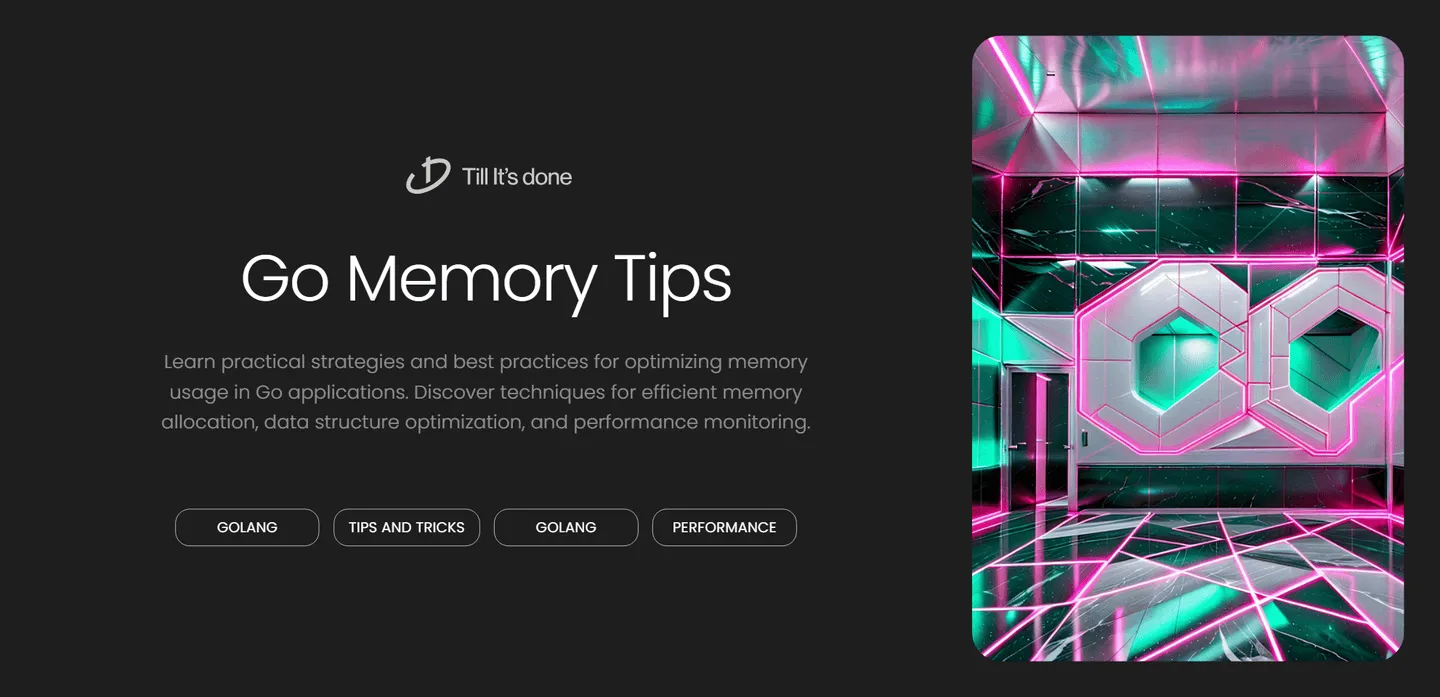- Services
- Case Studies
- Technologies
- NextJs development
- Flutter development
- NodeJs development
- ReactJs development
- About
- Contact
- Tools
- Blogs
- FAQ
Optimize Memory Usage in Go Applications
Discover techniques for efficient memory allocation, data structure optimization, and performance monitoring.

Optimizing Memory Usage in Go Applications

Memory management is crucial for building efficient Go applications. While Go’s garbage collector handles most memory-related tasks automatically, understanding and implementing proper memory optimization techniques can significantly improve your application’s performance. Let’s explore some practical strategies to optimize memory usage in your Go applications.
Understanding Memory Allocation in Go
When writing Go applications, every allocation counts. The way we handle data structures and manage resources directly impacts our application’s memory footprint. Memory optimization isn’t just about reducing usage—it’s about using memory more efficiently.
Use Sync.Pool for Temporary Objects
One of the most effective ways to reduce memory allocations is using sync.Pool. This mechanism allows you to reuse temporary objects, reducing the pressure on the garbage collector:
var bufferPool = sync.Pool{ New: func() interface{} { return new(bytes.Buffer) },}
func processData(data []byte) { buffer := bufferPool.Get().(*bytes.Buffer) defer func() { buffer.Reset() bufferPool.Put(buffer) }()
// Use buffer for processing}
Pre-allocate Slices When Possible
If you know the size of your slice beforehand, pre-allocating it can prevent multiple resize operations:
// Instead ofdata := make([]int, 0)for i := 0; i < 10000; i++ { data = append(data, i)}
// Do thisdata := make([]int, 0, 10000)for i := 0; i < 10000; i++ { data = append(data, i)}Advanced Memory Optimization Techniques
Optimize String Operations
String concatenation can be memory-intensive. Use strings.Builder for efficient string operations:
var builder strings.Builderbuilder.Grow(100) // Pre-allocate if you know the approximate sizefor i := 0; i < 100; i++ { builder.WriteString("item")}result := builder.String()
Use Proper Data Structures
Choose appropriate data structures based on your use case. For instance, use maps instead of slices for lookups, and consider using struct fields instead of map[string]interface{} when the structure is known:
// Instead oftype Config map[string]interface{}
// Usetype Config struct { Name string Version int Feature bool}Monitoring and Profiling
Remember to regularly monitor your application’s memory usage using Go’s built-in tools:
import _ "net/http/pprof"
func main() { go func() { http.ListenAndServe(":6060", nil) }() // Your application code}Final Thoughts
Memory optimization is an ongoing process that requires careful consideration and monitoring. By implementing these techniques and regularly profiling your application, you can maintain efficient memory usage and improve overall performance.

 Web Developers คืออะไร? สำคัญแค่ไหน Web Developer คืออาชีพที่มีทักษะด้านโปรแกรมมิ่ง และมีการเรียนรู้ในเทคโนโลยีใหม่ ๆ เพื่อพัฒนางานอย่างต่อเนื่อง และมีความสำคัญกับธุรกิจในยุคดิจิตัลแบบนี้เป็นอย่างมาก
Web Developers คืออะไร? สำคัญแค่ไหน Web Developer คืออาชีพที่มีทักษะด้านโปรแกรมมิ่ง และมีการเรียนรู้ในเทคโนโลยีใหม่ ๆ เพื่อพัฒนางานอย่างต่อเนื่อง และมีความสำคัญกับธุรกิจในยุคดิจิตัลแบบนี้เป็นอย่างมาก  จุดเด่นของ React JS คือ ดียังไงกับการทำ Mobile App React JS เป็นไลบรารีที่สนับสนุนการพัฒนาแอปพลิเคชันแบบ Single Page พร้อมรองรับการสร้างแอปบนมือถือด้วย React Native แต่ทำอย่างไร มาดูกันครับ
จุดเด่นของ React JS คือ ดียังไงกับการทำ Mobile App React JS เป็นไลบรารีที่สนับสนุนการพัฒนาแอปพลิเคชันแบบ Single Page พร้อมรองรับการสร้างแอปบนมือถือด้วย React Native แต่ทำอย่างไร มาดูกันครับ  Flutter คืออะไร ฟรีมั้ย การพัฒนาแอปพลิเคชันในยุคดิจิทัลนี้ Flutter ได้กลายเป็นหนึ่งในเครื่องมือที่ได้รับความนิยมอย่างมากในวงการ แล้ว Flutter คืออะไร แล้วใช้งานฟรีหรือไม่?
Flutter คืออะไร ฟรีมั้ย การพัฒนาแอปพลิเคชันในยุคดิจิทัลนี้ Flutter ได้กลายเป็นหนึ่งในเครื่องมือที่ได้รับความนิยมอย่างมากในวงการ แล้ว Flutter คืออะไร แล้วใช้งานฟรีหรือไม่?  อยากสร้าง Mobile App จะเลือกใช้โปรแกรมเขียน Mobile App การเลือกโปรแกรมเขียน Mobile App มีเครื่องมือกับภาษาอะไรให้เลือกใช้งานกันมากมาย ควรพิจารณาอย่างไรเพื่อให้มีประสิทธิภาพและตรงตามความต้องการของโปรเจกต์
อยากสร้าง Mobile App จะเลือกใช้โปรแกรมเขียน Mobile App การเลือกโปรแกรมเขียน Mobile App มีเครื่องมือกับภาษาอะไรให้เลือกใช้งานกันมากมาย ควรพิจารณาอย่างไรเพื่อให้มีประสิทธิภาพและตรงตามความต้องการของโปรเจกต์  Next.js คืออะไร? มาเริ่มเขียนเว็บด้วย Next.js กันดีกว่า Next.js เป็น Framework สำหรับสร้างเว็บไซต์ด้วย React ที่ช่วยให้สามารถสร้างเว็บไซต์ที่มีประสิทธิภาพและใช้งานได้จริง และรองรับ SEO ได้ดีขึ้นอีกด้วย
Next.js คืออะไร? มาเริ่มเขียนเว็บด้วย Next.js กันดีกว่า Next.js เป็น Framework สำหรับสร้างเว็บไซต์ด้วย React ที่ช่วยให้สามารถสร้างเว็บไซต์ที่มีประสิทธิภาพและใช้งานได้จริง และรองรับ SEO ได้ดีขึ้นอีกด้วย  รู้จักกับ บริษัท Software House คืออะไร ทำอะไรบ้าง Software House คือศูนย์บริการที่ครบวงจรในการพัฒนาเทคโนโลยี ช่วยสนับสนุนธุรกิจในยุค 4.0 และสร้างโอกาสใหม่ ๆ ในตลาดการแข่งขันที่มีการเปลี่ยนแปลงอย่างรวดเร็ว
รู้จักกับ บริษัท Software House คืออะไร ทำอะไรบ้าง Software House คือศูนย์บริการที่ครบวงจรในการพัฒนาเทคโนโลยี ช่วยสนับสนุนธุรกิจในยุค 4.0 และสร้างโอกาสใหม่ ๆ ในตลาดการแข่งขันที่มีการเปลี่ยนแปลงอย่างรวดเร็ว Talk with CEO
We'll be right here with you every step of the way.
We'll be here, prepared to commence this promising collaboration.
Whether you're curious about features, warranties, or shopping policies, we provide comprehensive answers to assist you.


